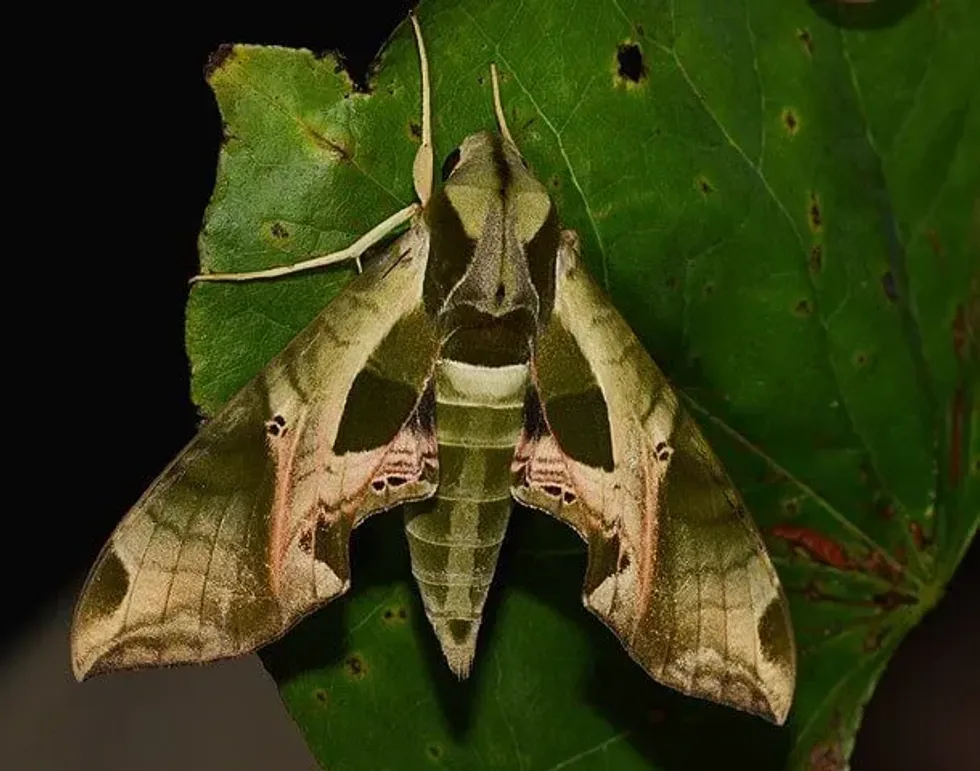Here is a unique moth to engage you with some interesting information about their species. A moth that is found around the country to North America to its south of Texas. They are found flying after dusk in the dark night. Yes! A Pandorus sphinx moth!
It is challenging to notice one due to the camouflage capability of this creature. A moth with attractive patterns formed with patches of brownish and greenish shades. It looks as attractive as in the photo. It is found in the woodlands and vineyards of America.
Being oviparous in nature, it lays eggs that hatch into larvae. The larvae have their own variant appearance. The larvae are divided into further segments. The head segment has a horn at the end of the abdomen which is later replaced by a button as it grows.
The horn is special to the larvae. Not every larva grows into an adult due to attack by a parasite and other threats. Every pandora is unique with its dramatic pattern and is worth capturing in a photo.
If the uniqueness of Pandorus sphinx moths makes you interested to read more about similar species, you can read about the Indian meal moth and the banded tussock moth.
Pandorus Sphinx Moth Interesting Facts
What type of animal is a Pandorus sphinx moth?
Pandorus sphinx of the genus Eumorpha is one of the insects. They are North American green moths from the family Sphingidae.
What class of animal does a Pandorus sphinx moth belong to?
This sphinx with the scientific name Eumorpha pandorus belongs to the class Insecta and phylum Arthropod.
How many Pandorus sphinx moths are there in the world?
There are no documentaries reporting the number of Pandorus sphinx moths around the world. While there are more than 160000 species of moth recorded. Since the population of Pandorus sphinx moth remains undecipherable, there are just predictions stating them to be found in considerable numbers residing around its native habitat.
Where does a Pandorus sphinx moth live?
Pandora sphinx moth is found in and around North America. It is found in the eastern, southeastern, and central parts of North America from Ontario and Nova Scotia until the south of Texas and Florida. It is speculated that Pandorus sphinx is endemic as it is not recorded at either location outside its native habitat.
What is a Pandorus sphinx moth's habitat?
A Eurmorpha pandorus is reported to be found most likely in vineyards, gardens, meadows, or near rivers. Also, it is found near forest edges or inside woodlands. The most potential habitat for pandora sphinx is the one with grape, Boston ivy, or Virginia creeper.
Who do Pandorus sphinx moths live with?
There is no information stating who does a Eumorpha pandorus lives with. According to the predictions made, Pandora sphinx moth is calm in nature and does not report any aggressive behavior with any species.
How long does a Pandorus sphinx moth live?
A Eumorpha pandorus Hübner is reported to live approximately for one year. The female dies shortly after reproducing.
How do they reproduce?
A female Eumorpha pandorus is said to lay eggs underneath the grape leaves which hatch into larvae in few days. Larvae are found instar their hostplants and larva feed on the leaves grape, pepper vine, and Virginia.
There are many variations in their instars. The instar further grows into a Pandorus sphinx moth caterpillar. The caterpillars are found underneath the leaves.
As the caterpillars pupate, they have the capability of changing their color. The caterpillar of a big green moth, thus, can be found as a pink caterpillar. Also, the caterpillars are recorded in yellow-green, green, and orange colors.
As the caterpillars pupate, the pupa feeds in soil. The pupa further emerges into a Eumorpha pandorus in or above the soil.
What is their conservation status?
According to the IUCN Red List of Threatened Species, Pandorus sphinx moth is recorded under the Not Evaluated category of Species. According to the reports, there are considerable Pandorus sphinx moths found locally in around the north of America Florida, Texas, and Nova Scotia.
Pandorus Sphinx Moth Fun Facts
What do Pandorus sphinx moths look like?
An adult Eumorpha pandorus and its larva, pupa, or caterpillar differ in appearance. An adult has a large, thick body that is taper towards the rear.
The narrow angular wings with unusual shapes are present over the body of an adult. Forewings are longer while hindwings are dwarf.
The wings of an adult moth are patterned beautifully with velvet brown and olive green patches and pink edges. The thorax and the head are dark green color at the middle while the rest is a lighter shade of muted green.
Female adults are said to be longer and bigger in size as compared to the male adults.
The thorax and the head are dark green color at the middle while the rest is a lighter shade of muted green. While caterpillar is recorded in various colors, and are considerably large in size.
A body of a caterpillar is studied and recorded to be divided into segments. The third segment of the caterpillar is noticed to be swollen into which head and the first to thoracic segments are to be drawn.
Segment two is noticed to have a white-yellow spot while the succeeding segments have large oval-shaped spots. There is also a whiplike horn in the early instar of larva which is later replaced with a button in the last stage.

How cute are they?
The dramatic patterns formed with dark and muted shades of brown, yellow, green, and pink over the wings and body of the moth are surely a treat to your eyes. You may or may not find them cute but they are sure to please you with their attractive camouflage color and pattern.
But unlike the rosy maple moth, it is not considered the cutest of all moths.
How do they communicate?
Ears and mouth are the most common means of communication found in every species, but this moth lack ears, unlike the poodle moth. They do certainly communicate, but it's via scent. They do not produce any noise and are very peaceful.
How big is a Pandorus sphinx moth?
A Pandorus sphinx moth's size is unknown, but it is observed that females are bigger in size than males.
How fast can a Pandorus sphinx moth fly?
The Pandorus sphinx moth's flying speed is yet to be discovered, but its wingspan is around 3.3-4.5 in (8.2-11.5 cm). According to the reports it is said to have a considerable flying speed but is not as fast as a five-spotted hawk moth.
They tend to fly at night and are rarely spotted under the porch lights in the evenings.
How much does a Pandorus sphinx moth weigh?
There is particular information regarding the weight of Pandorus sphinx moth. Since the heaviest moth weighs up to 1.05 oz (30 g), Pandorus sphinx moth is considered to have negligible weight.
What are the male and female names of the species?
There are no particular names assigned to the species in regards to its sexes. You can call them male Pandorus sphinx moth and female Pandorus sphinx moth to differentiate the species on the basis of their sex.
What would you call a baby Pandorus sphinx moth?
The baby of Pandorus sphinx moth is either called larva or maybe caterpillar. There is no different scientific term assigned to call a baby Pandorus sphinx moth. Pandorus sphinx moth caterpillars are recorded to feed on the same diet as a Pandorus sphinx moth, i.e., grapevine, and leaves of Virginia creeper.
What do they eat?
A Eumorpha pandorus are herbivorous in nature. Their food includes leaves of grapes and Virginia creeper. They are noticed to feed on the nectar of flowers.
Are they dangerous?
They do not possess any danger against any species or environment. They are said to add up to the productivity of nature.
Sphinx moths neither bite and nor are recorded to be harmful. Rather than killing the sphinx moth, they can be shooed away by picking and throwing them. They have a short life span and are advised not to be harmed.
Would they make a good pet?
A Sphingidae green moth needs an enormous amount of free space to fly and stay peaceful and comfortable. Petting such a species of moth for fulfilling your desires is not a satisfying idea, but they do make a good pet if fed their food and a considerable amount of space to cage them.
Did you know...
Pandorus sphinx moths were first described by Jacob Hübner in 1821 and were thus, named after him as Pandorus Hübner.
The caterpillars are found in orange, green, yellow, brown, and pink colors.
A Eumorpha pandorus flies mainly during dusk in the night.
Caterpillar has a horn at the end of the abdomen which is further replaced by a button in its last instar.
How many eggs does a sphinx moth lay?
A sphinx moth lays approximately 1000 eggs on the lower side of food plants which hatch within few days.
Why is Pandorus sphinx moth green or brown?
A Eumorpha pandorus is a green, yellow-brown, and slightly pink species with wings over the body that are dramatically patterned. The colors allow them to camouflage which helps the moths hide around the habitat from their enemies.
Here at Kidadl, we have carefully created lots of interesting family-friendly animal facts for everyone to discover! For more relatable content, check out these promethea moth facts and morpho butterfly facts pages.
You can even occupy yourself at home by coloring in one of our free printable Pandorus sphinx moth coloring pages.










